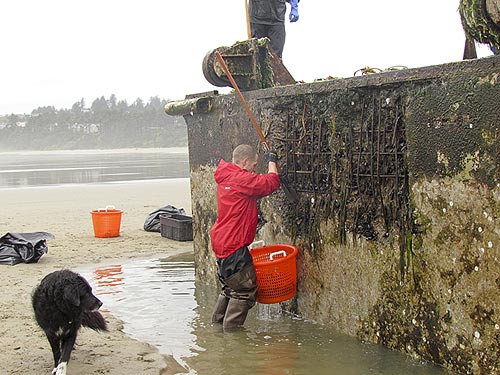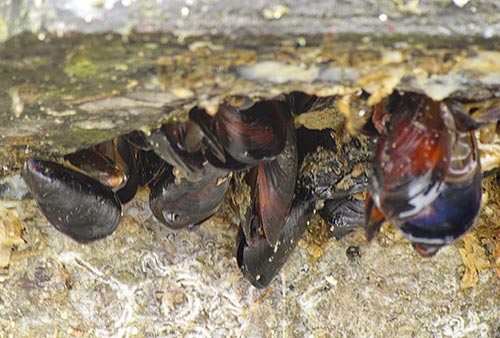 |
Reality of Debris Off Oregon Coast: Spotting It Early Not Likely
Published 06/26/2012

(Oregon Coast) - There's little doubt that a lot of debris from last year's tsunami in Japan is heading to the Oregon coast; indeed there's little doubt it's starting to pile up. But what can really be done about it? Is it possible to spot the larger objects before they hit the shore – as many politicians are suggesting, even demanding? (Tsunami dock photos by Terry Morse)
NOAA and numerous other agencies are in the middle of formulating their responses to the smaller debris that is expected to hit in greater and greater numbers over the coming years. There are many questions and issues about how to prepare for larger objects like the dock from Japan that hit the beach at Newport recently and the massive barrel-like objects that showed up near Coos Bay this week. Among them are possible damage to the ecosystems of the coast because of the invasive species they can carry and the dangers to seafaring vessels in this area.
Charlie Plybon, Oregon manager for the Surfrider Foundation, is part of one of several agencies putting their heads together on the issue. CoastWatch, Surfrider, SOLVE, the Washed Ashore project, Oregon Sea Grant and the Oregon Marine Debris Team are all engaged in coming up with responses to these issues, and they will be making a small announcement later this week regarding some of the plans.

In the meantime, however, Plybon admits spotting the larger stuff before it makes landfall on beaches is unlikely. Aside from increased satellite surveillance of the oceans and a few more eyes in boats offshore, the expectations for spotting larger debris ahead of time are likely too high.
Is it reasonable to hope to spot these bigger pieces beforehand?
“I think that's where the question is,” Plybon said. “I don't think we really know.”
There is no technology in existence that can scan the oceans as a radar would for incoming large objects. Plybon thinks NOAA may at some point obtain greater access to satellites, but that will take further national security clearances and more money, and even then that may not do much good. The ocean is simply too big.
“They say that if the ocean was a football field then that boat that nearly washed up off Canada would be a pinhead,” Plybon said.
The realities of being able to spot such items floating in the ocean are much more complex, and Plybon thinks expectations are too high. The public – and certainly politicians who are now prodding NOAA to do more – may be in for a rude awakening.

“If we don't understand how satellite imagery works, what the resources are for covering the ocean and being able to see these things, then we kind of expect that we can see anything,” Plybon said. “I don't think that's the case. That's what we're learning. We don't know the ocean as well as people would think. We don't have the resources to fully see the ocean.”
Surfrider, CoastWatch, and the other agencies involved are looking at a large variety of possible solutions and responses to the tsunami debris both big and small. Most responses and solutions would take more money and resources, especially if it involved more vessels from the U.S. Coast Guard and more technology and staff from NOAA. Even citizen involvement, like CoastWatch or SOLVE, will require more resources.
All this comes at a time when the Obama administration has been discussing larger and larger cuts to NOAA and its debris programs. Other issues that will have to be addressed include the disposal of much larger objects, like the dock at Newport, which will cost Oregon State Parks and Recreation $84,155.
More About Oregon Coast hotels, lodging.....
More About Oregon Coast Restaurants, Dining.....
 |
 |
 |
LATEST OREGON COAST NEWS STORIES
Oregon Coast, Valley and Likely Washington Coast to Get Some Aurora Borealis ... |
Back to Oregon Coast
Contact Advertise on BeachConnection.net
All Content, unless otherwise attributed, copyright BeachConnection.net Unauthorized use or publication is not permitted
Secrets of the Season |
Unusual Travel Articles TravelParanormal.com allows you to submit your own creepy tale or debunk one - or see up-to-the-minute news headlines about travel and the paranormal. News Headlines from All Over Oregon Need to scan Oregon headlines? Constantly updated news from all over Oregon: a comprehensive, up-to-the-minute display of news headlines from a variety of media |




































